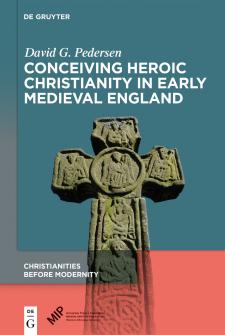- Author Resources
-
- Christianities before modernity
- Early Drama, Art, and Music
- Festschriften, Occasional Papers, and Lectures
- Late Tudor and Stuart Drama
- Ludic Cultures, 1100-1700
- Monastic Life and Venerated Spaces
- Monsters, Prodigies and Demons
- New Queer Medievalisms
- Northern Medieval World
- Old English Newsletter Subsidia
- Premodern Transgressive Literatures
- Research in Medieval and Early Modern Culture
- Publications of the Richard Rawlinson Center
- Studies in Iconography: Themes and Variations
- Studies in Medieval and Early Modern Culture
- Index - Books by author
- Index - Books by title
- Newsletter
- Directory
- Contact Us
Christianities before Modernity

Challenging the perception of Christianity as a unified and European religion before the sixteenth century, this series interrogates the traditional chronological, geographical, social and institutional boundaries of premodern Christianity. Books in this series seek to rebuild the lived experiences and religious worlds of understudied people as well as landmark disputes and iconic figures by recovering underappreciated vernacular sources, situating localized problems and mundane practices within broader social contexts and addressing questions framed by contemporary theoretical and methodological conversations.
Christianities before Modernity embraces an interdisciplinary and comparative approach, publishing on history, literature, music, theater, classics, folklore, art history, archaeology, religious studies, philosophy, gender studies, anthropology, sociology and other areas. Grounded in original sources and informed by ongoing disciplinary disputes, this series demonstrates how premodern Christians comprised diverse and conflicted communities embedded in a religiously diverse world.
Keywords: Christianity, history of religions, longue durée, theory and method of medieval studies, global Middle Ages, inter‐connectivity, late antiquity, medieval and early modern studies.
Geographical Scope: Afro‐Eurasia and the Atlantic World
Chronological Scope: Medieval and Early Modern
- Rabia Gregory, University of Missouri, Columbia, USA, Series Editor
- Kathleen E. Kennedy, University of Bristol, England, Series Editor
- Charlene Villaseñor, UCLA, USA, Series Editor
- Adnan A. Husain, Queen's University, Canada
- István Perczel, Central European University, Hungary
- Eyal Poleg, Queen Mary University of London, England
- Carl S. Watkins, Magdalene College, Cambridge, England
To submit a proposal or completed manuscript to be considered for publication by Medieval Institute Publications or to learn more about the series, contact Tyler Cloherty or Emily Winkler, the acquisitions editors for the series.
All Books in this Series

Conceiving Heroic Christianity in Early Medieval England
By David G. Pedersen
Unlike much of early medieval Europe, the early English converted to Christianity through missional efforts, not martial conquest. Thus early English converts had freedom to construct their Christian identity, producing a religious subjectivity that differed from the Latinate perspective of the missionaries who converted them. This book investigates lay texts to undermine monolithic conceptions of medieval Christianity by revealing a uniquely English religious subjectivity evident in Old English wisdom literature.
ISBN: 978-1-50152-664-0 (hardcover), 978-1-50151-678-8 (eBook) © 2025
Preorder link coming soon!

The Language of Heresy in Late Medieval English Literature
By Erin K. Wagner
Vernacular writers of late medieval England were engaged in global conversations about orthodoxy and heresy. Entering these conversations with a developing vernacular required lexical innovation. The Language of Heresy in Late Medieval English Literature examines the way in which these writers complemented seemingly straightforward terms, like heretic, with a range of synonyms that complicated the definitions of both those words and orthodoxy itself. This text proposes four specific terms that become collated with heretic in the parlance of medieval English writers of the 14th and 15th centuries: jangler, Jew, Saracen, and witch. These four labels are especially important insofar as they represent the way in which medieval Christianity appropriated and subverted marginalized or vulnerable identities to promote a false image of unassailable authority.
ISBN: 9781501519239 (hardcover), 9781501512094 (eBook) © 2024

Trauma and Recovery in Early North African Christianity
Scott David Harrower
Embedded within the texts of (1) The Scilitan martyrs, (2) The account of Montanus, Lucius, and their Companions, (3) The martyrdom of Marian and James, (4) and The martyrdom of Cyprian of Carthage there is a powerful guide for living in the aftermath of trauma. This book vividly demonstrates that such hagiographies played a vital role for helping trauma survivors recover and live in the aftermath of disaster.
ISBN: 9781501518904 (hardcover), 9781501511264 (eBook) © 2024

